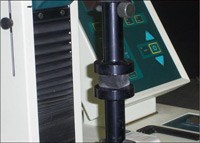
What does the data sheet mean?
Different suppliers choose to put different technical data on their data sheets. Some are important, some are irrelevant. Here is our clear English guide to all the terms used, and their practical importance.
Adhesion
Adhesion is a general term for the ability of a material (especially an adhesive) to stick to another surface. PVC foams are unique amongst foam sealants, that the “dry” foam face will, over time, stick to another surface. So PVC foams seal by compression and adhesion. Most foams only seal by compression, unless they are adhesive coated.
Compression Deflection
Having compressed Techniseal, its own elasticity causes it to exert a force on the materials it is compressed between. This is the compression deflection.. It is one of the measurements of how effective the foam sealant is. Compression deflection is measured after 30% compression for 1 minute, so it is a short term test. See also Force to Compress and Compression Set.
Compression Set
When materials have been compressed for some time, many become permanently compressed and will no longer recover. This is compression set. It is a long term test that is used for comparing different foam types, so it does not normally appear on data sheets. It is not too important for PVC foams as the dry face forms an adhesive bond with time. It is a major disadvantage of PE foams which become less effective with time.
Density
Density is the weight of a material compared to volume. It depends partly on the chemical nature of the polymer but much more on how much air it contains. A higher density, like for like, means a firmer foam. But due to formulation differences density can be misleading, and force to compress is a better measure.
Elongation
Elongation is part of a tensile test and is the percentage stretch at the point of breakage. Not relevant in most applications.
Flame Resistance
The ability of a material to resist ignition and the spread of flame. It is generally tested by applying fire to a strip of material under standardized conditions, then measuring the amount of fire spread in a specific time. PVC is inherently flame resistant due to the high proportion of chlorine in its composition and some grades have passed certain standards, such as British Standard 476 part 7.
Force to Compress
The best measurement of the firmness of a foam. It is measured by compressing a foam between two anvils on a tensile test machine and measuring the force required to achieve 30% compression.
This is a quantified measurement of pressing down on a foam with your thumb. Foams with a high force to compress will act as a “spacer” but may be difficult to compress to the required 30% to form an effective seal. That is why Techniseal 220, our medium firm grade, is our best selling grade. Compression deflection is tested exactly the same way, but measured after a dwell period of 1 minute.
Hardness – see Shore Hardness
Liner
The removable protection, normally a paper, that is wound into an adhesive coated material to stop it sticking to itself. In the case of Techniseal, the liquid PVC is actually cast onto the paper during manufacture, then the open side of the foam is coated with adhesive. The liner also acts as a positioning aid, reinforcing the foam and preventing stretch.
Peel Adhesion
An adhesive test method where a strip of adhesive is bonded to a specified surface (normally stainless steel) under carefully controlled conditions, then peeled from that surface in a tensometer. It is usually peeled back on itself at 180o, but may be peeled at 900.. The average force is measured. This is not very important for most applications as the adhesive on the foam is for positioning, not permanent fixing. It may be important, for instance, if the foam is applied to a curved surface and there is a delay before final fixing in position.
Shore Hardness
A method of measuring material hardness that involves bringing a probe into contact with the surface and measuring the indentation using a Shore Durometer. Different probes are used for different materials (from concrete to soft foams) so the measurements quote the scale being used. Soft foams generally use the OO scale. Shore hardness is quite widely used but is not as meaningful as force to compress.
Tensile Strength
A standard size piece of material is stretched in a tensometer under standard conditions until it breaks, then the maximum force is recorded. Often stated on data sheets but irrelevant in most applications.
Thermal Conductivity
The rate of transmission of heat through a material, expressed in Watts per square metre per degree Centigrade. Techniseal is sometimes used as a thermal break, and the new building regulations are making insulation values (the inverse of conductivity) more important.
Water Absorption
Measured by comparing the weight of a piece of material before and after immersion in water for a period of time. Misleading with closed cell foams, as it implies a degree of water penetration into the foam. The only water absorption that can occur is at the cut edges of the foam where the cells have been cut open. The foam itself does not absorb water.
For all enquiries, please call our sales office on +44 1628 642800 and talk to an expert!
